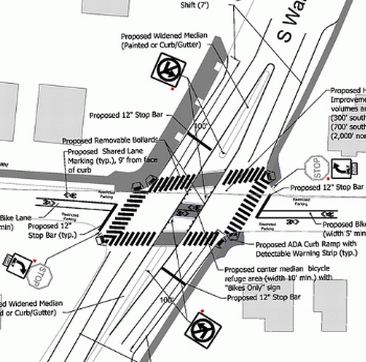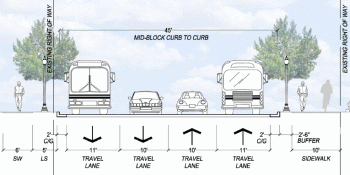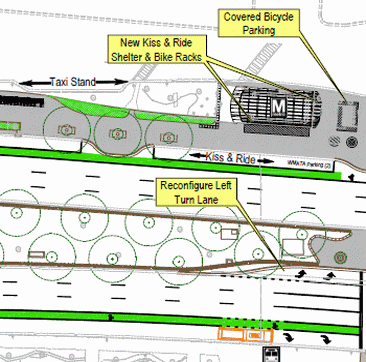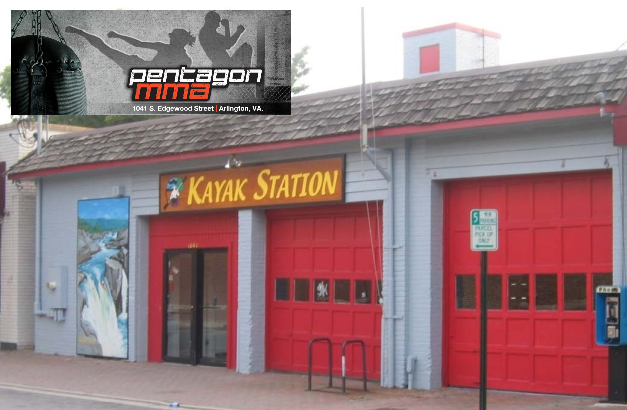Bike Trail Benefits
Recently the Washington Boulevard Trail project has come under criticism from the Urban Forestry Commission and the Penrose Neighborhood Association due to the number of trees that would be impacted by it's construction. While the potential loss of trees is unfortunate, the myriad environmental, health and mobility benefits of the trail seem to have been lost in the shuffle.
Project Overview
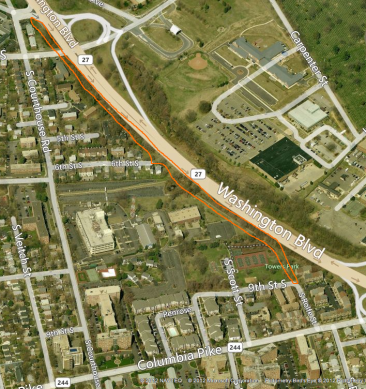 The Washington Boulevard trail project would construct a new bike and pedestrian trail along the west side of Washington Boulevard between Route 50 and South Rolfe Street just shy of Columbia Pike by way of Towers Park. Phase I of the trail was completed in 2009 as part of a water main project and runs from Route 50 to the South Courthouse Rd exit of Washington Blvd. Phase II will complete the trail and is currently at 90% design completion (the approximate area is outlined in yellow on the map). The trail is identified as high-priority project in the Arlington Master Transportation Plan and would link the Arlington Boulevard Trail to planned bikeways coming to the east end of Columbia Pike and to a long-term project that would provide a new connection under I-395 via the Army Navy Country Club called the "Hoffman-Boston Connector".
The Washington Boulevard trail project would construct a new bike and pedestrian trail along the west side of Washington Boulevard between Route 50 and South Rolfe Street just shy of Columbia Pike by way of Towers Park. Phase I of the trail was completed in 2009 as part of a water main project and runs from Route 50 to the South Courthouse Rd exit of Washington Blvd. Phase II will complete the trail and is currently at 90% design completion (the approximate area is outlined in yellow on the map). The trail is identified as high-priority project in the Arlington Master Transportation Plan and would link the Arlington Boulevard Trail to planned bikeways coming to the east end of Columbia Pike and to a long-term project that would provide a new connection under I-395 via the Army Navy Country Club called the "Hoffman-Boston Connector".
Tree Removal
Because of the hilly nature of the land along Washington Blvd, approximately 2.7 acres of currently vegetated land would need to be disturbed during the construction process. This results in 297 trees that could potentially be impacted, of those 186 (of which 6 are dead) would have to be removed, while the project would try to preserve and protect the remaining 111. Of those that would need to be removed only 17 are "large" (20" diameter+) while over half (91) are "small" (under 10" in diameter).
Clearly, this is a LOT of trees and not an ideal situation, but what do we get in exchange?
New Trees
Any trees removed would be replaced under the County's Tree Removal formula - the current calculation would result in the planting of 250 new trees. If space allows, they would be planted within half a mile of the project site. While the trees planted would be small, they would all be native species (unlike many of those being removed) and would eventually, after decades of growth, result in a fuller tree canopy and improved air quality in the area. While the County's trail guidelines recommend not planting new trees within 10' of the trail (so as to avoid tree roots destroying the trail over time) much of the area being dug up is only being disturbed in order to regrade it - those areas are prime locations for replanting and will eventually help shade the trail. In addition, Towers Park which the trail runs through is fairly bare and would benefit from the planting of many new trees (at least in my opinion).
Increased Cycling
Building new bicycle infrastructure is vital to encouraging additional people to bike, especially off-street infrastructure like trails. There are many folks who are interested in biking but are intimated by the idea of sharing the road with cars. Trails and other off-street routes function like training wheels allowing new cyclists to come up to speed with urban cycling in a slow, controlled way. The Washington Boulevard trail would be the only off-street route linking the Columbia Pike corridor with points north other than the W&OD trail in the western portion of the County.
Public Health
With increased cycling comes public health benefits. Cycling, whether as recreation or as transportation is excellent exercise and helps combat the obesity epidemic sweeping our nation.
Decreased Carbon Footprint
With increased cycling comes environmental benefits. Some trips that would previously have been taken by car will instead be taken by bicycle resulting in decreased emissions. Recreational trips may displace other forms of recreation like watching TV or going to the movies which require electricity providing further emissions benefits.
Increased Park Safety
One request that frequently comes up in Neighborhood Conservation plans is for increased police presence in our parks. Many are concerned about vandalism and crime in these often out-of-the-way areas. Putting the Washington Boulevard trail through part of Towers Park would provide many additional "eyes on the park" throughout the day as cyclists and pedestrians pass through helping deter crime and vandalism in the park.
A New Generation of Environmentalist
Finally, the best way to ensure that our parks and natural areas are preserved in the future is by instilling a love and passion for nature in our children. By increasing access to our parks and natural areas, and by encouraging outdoor activities like cycling and jogging, trails help bring this love and passion to people, especially young people. Those spending all day inside staring at the TV are much less likely to care about trees and streams as they age.
The Washington Blvd trail would be especially useful in this regard as Towers Park is relatively cut-off from the rest of the neighborhood, surrounded on 3 sides by Washington Blvd and Department of Defense property. To access it from the majority of Penrose, one must walk down South Courthouse Road to Columbia Pike, walk East down the Pike and then double back up to the park on Rolfe or Scott Street. The trail would make for a much more direct and pleasant path for residents using the planned trail access at 6th Street.
Alternatives? Improvements?
The Penrose Association's letter is careful to oppose the trail project "as currently designed". The Urban Forestry Commission, however, go so far as to recommend that the trail be completely scrapped as their is a "safe alternative for bicycle and multiuse...available along South Courthouse Road" which is absurd to anyone who has attempted to bike in the area. South Courthouse is a relatively busy, extremely hilly street with significant speeding problems. Biking on it is fairly common, but only by cyclists who are already quite comfortable with on-street cycling. South Courthouse Road doesn't actually get you to Towers Park, however, to do that you have to traverse four blocks of Columbia Pike. Cycling on-street on Columbia Pike is something done only by the bravest and most confident cyclists, and the alternative is narrow sub-standard crumbling sidewalks. While improvements are coming to the portion of Columbia Pike, and some improvements are coming to South Courthouse Road, it will never be welcoming to beginning cyclists like an off-street trail would be.
Other suggestions I've heard include narrowing the trail, narrowing the buffer around the trail and making portions of the trail on a raised "boardwalk" to avoid damaging significant trees. We have some existing boardwalk section of trail in Northern Virginia. In my experience they are all dangerously slippery at least a portion of the time - many are dangerously slippery ALL the time. Narrower trails present obvious safety concerns. Narrowing the buffer on either side of the trail is something that seems like a reasonable place to further compromise as long as it doesn't adversely affect sight-lines on the trail.
Building a project like the Washington Boulevard trail is a balancing act. The route that is best from a transportation perspective is likely not the best from a tree-preservation perspective; neither is probably the most cost effective route. County Staff weigh these and many more factors when planning these projects. To not build the project at all or to make further compromises that impede the trail's effectiveness as a transportation corridor would lose us all of the benefits outlined above. If you feel as I do that those benefits outweigh the loss of trees, please join me in signing the online petition below:
